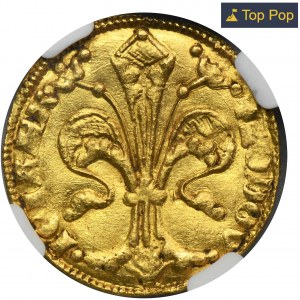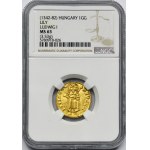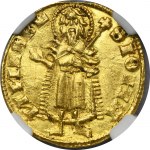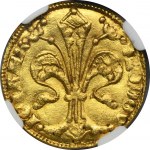Hungarian goldgulden issued by the descendant of the Andegawen family, later king of Poland.
A 1338 treaty between Ludwig's father and King Casimir III the Great, Ludwig's uncle on his mother's side, confirmed Ludwig's right to inherit the Kingdom of Poland should his uncle die without a son. In return, Ludwig was obliged to help his uncle reoccupy the lands Poland had lost in previous decades. He bore the title of Duke of Transylvania from 1339 to 1342, but never ruled the province.
Louis of Hungary was king of Poland from 1370-1382, having been crowned in 1370 after the death of Casimir III the Great.
As a result of the fact that Louis had no sons, he wanted his subjects to recognize the right of his daughters to inherit from him in both Hungary and Poland. To this end, he issued the so-called Kosice Privilege (now Košice in Slovakia) in 1374, defining the freedoms of the Polish nobility. Thanks to this, his rule in Poland was not very popular.
A beautiful coin that impresses with its presence.
Obverse: lily of Florence
LODOVICI REX
Reverse: standing Saint John
S IOHANNES B
Diameter 21 mm, weight 3.53 g
One of the ornaments of the 11th Auction is a florin of Louis of Hungary - a coin outstanding for its state of preservation (MS 63), but also outstanding for its historical context. Let's look at it in a little more detail. Let's start with the name - florin or ducat? (Both names appear in auction descriptions). A floren in the strict sense of the word is a gold coin weighing about 3.5 grams minted since the mid-13th century in Florence. The ducat, on the other hand, is a gold coin minted from the second half of the 13th century in Venice. Both became international money. In some countries, their prestige was so significant that all gold coins were called "florins" or "ducats." Across Central and Eastern Europe in the 14th century, gold coins were called florins. So here we have the matter settled - not a ducat, but a florin. Thinking about the gold minting of the Polish Middle Ages, we immediately think of the floren of Wladyslaw Lokietek and ... often our reflection ends there. Wrong - our golden medieval period is not so poor. It would be appropriate to mention here, for example, the gold coin of Alexander Jagiellon (not preserved to our times, unfortunately) and the rather rich gold minting associated with Poland: the gold brakteate of Wladyslaw Laskonogi (13th century), or the Silesian gold coins - the florins of Świdnica of Bolek II and Legnica of Waclaw II (14th century). Also associated with Poland, of course, is the florin of Louis of Anjou, visible below, who, in addition to being king of Hungary, was also king of Poland (1370-1382). Gold florins appeared in Hungary in 1325 with Charles I Robert of the Andegavian dynasty, who took over the throne after the extinct Arpad dynasty. They were imitations of the gold coins of Florence. Both the drawing and the mint foot were imitated. On the obverse, they had a lily flower and a Gothic inscription with the monarch's name, and on the reverse, the figure of St. John the Baptist (who can be easily recognized by his "scythe-like" camel skin coat) in nimbus, with a staff ending in a cross in his left hand, and an obverse inscription with the saint's name. Louis of Anjou, son and successor of Charles I Robert, continued the gold issues initiated by his father. The Floren with a lily, however, was not the only type of Louis' gold coinage. Coins with the image of St. Ladislaus soon appeared, which were to become the basic model for Hungarian florins, including during the reign of Ladislaus Varnañczyk (so, again, minting related to Poland). As we can see, in the florin of Louis of Andegavia with a lily, various numismatic themes come into focus, which can become the basis for building extremely interesting collections.












